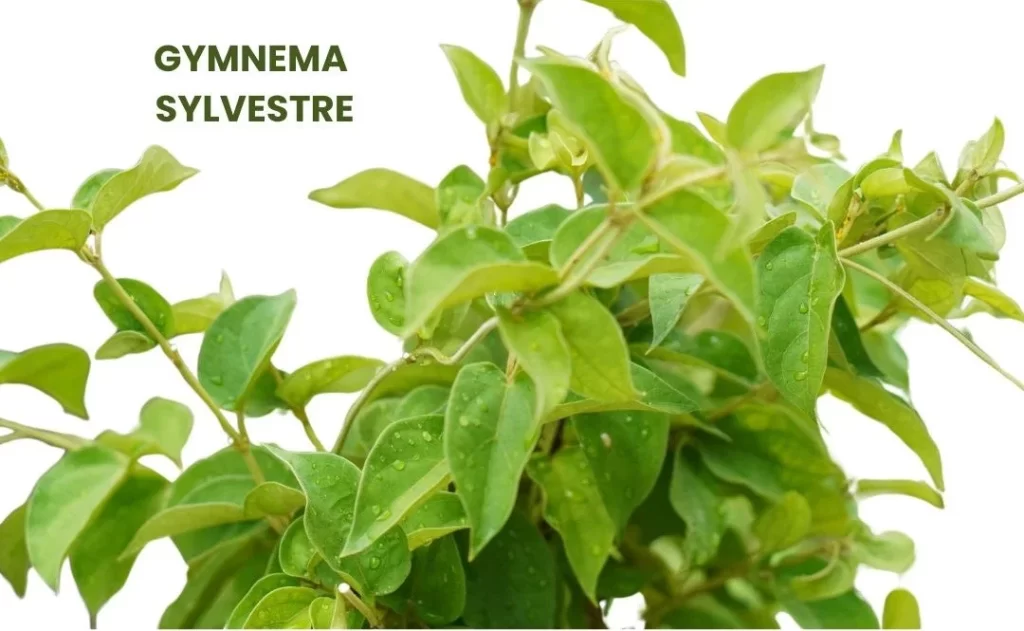Gymnema sylvestre, known locally as Mesharingi or Gurmar (meaning ‘sugar destroyer’), is an herb that has been used for centuries in traditional Indian medicine.
Revered for its remarkable ability to regulate blood sugar levels, it has earned the nickname ‘sugar-killer’.
Gymnema sylvestre belongs to the Asclepiadaceae family and has shown significant promise in treating diabetes mellitus and poisonous snake bites.
First proved by Lt. Col. R.N. Chopra, this plant has become an essential remedy in both traditional and homeopathic medicine.

Table of Contents
ToggleSOURCE INFORMATION
Scientific Classification
- Kingdom: Plantae
- Order: Gentianales
- Family: Apocynaceae (formerly Asclepiadaceae)
- Genus: Gymnema
- Species: Gymnema sylvestre
Origin and Historical Facts
- Origin: Gymnema sylvestre is native to the tropical forests of India, Africa, and Australia.
- Historical Usage: Traditionally used in Ayurvedic medicine for over 2,000 years, Gymnema sylvestre was primarily employed to treat diabetes.
- The plant’s name, Gurmar, translates to ‘sugar destroyer’, reflecting its ability to suppress the taste of sweetness and manage blood sugar levels.
- Medicinal Uses: Besides its role in managing diabetes, Gymnema sylvestre has been used to treat various ailments including malaria, snake bites, and digestive issues.
- It has also been explored for its potential to support weight loss and lower cholesterol.
Homoeopathic Application
- Primary Use: Gymnema sylvestre is prominently used as a remedy for diabetes mellitus, particularly effective in cases where there is a profuse passage of sugar-loaded urine.
- Other Uses: It is also employed in treating snake bites and alleviating symptoms related to excessive thirst, burning skin, and sexual weakness.
DRUG PATHOGENESIS
- Primary Action: Gymnema sylvestre primarily affects the urinary system, reducing sugar levels in the urine and alleviating symptoms of diabetes.
- Secondary Action: It has a significant impact on the skin and sexual systems, providing relief from burning sensations and improving sexual weakness.
KEY CHARACTERISTICS
- Diabetes Mellitus: Known as a ‘sugar-killer’ for its ability to reduce sugar levels in the urine.
- Urinary System: Profuse urination with high sugar content, causing significant weakness.
- Skin: Burning sensations all over the body and the presence of diabetic carbuncles.
- Thirst: Extreme thirst, often seen in diabetic patients.
- Sexual Weakness: Notable decrease in sexual power.
DETAILED ORGAN SYMPTOMS
Urinary System
- Profuse Urination: Patients experience frequent urination loaded with sugar.
- The urine is often white and copious, with high specific gravity.
- Weakness: After urinating, patients feel significantly weakened, often exclaiming, “this passing of urine in large quantities has made me very weak”.
Skin
- Burning Sensations: Patients feel a burning sensation all over their body.
- Diabetic Carbuncle: Presence of carbuncles, which are painful, swollen lumps on the skin commonly found in diabetic patients.
Tongue and Thirst
- Great Thirst: Patients often experience extreme thirst, a common symptom in diabetes.
Sexual System
- Sexual Weakness: Noticeable decrease in sexual power and performance.
MODALITIES
- Aggravation: Symptoms are worsened by excessive sugar intake and physical exertion.
- Amelioration: Symptoms are improved by hydration and rest.
WHAT ARE MODALITIES IN HOMOEOPATHY?
RELATIONSHIP WITH OTHER DRUGS
- Compare: Similar remedies include Syzygium jambolanum, which is also used for its anti-diabetic properties, and Lycopodium, which addresses digestive and urinary issues.
DOSE
- Potency of Choice: Typically used in mother tincture, 3x, and 6 potencies, depending on the patient’s symptoms and response to treatment.
FREQUENTLY ASKED QUESTIONS
What is Gymnema sylvestre used for?
- Gymnema sylvestre is primarily used to treat diabetes mellitus by reducing sugar levels in the urine.
- It is also used to treat snake bites and alleviate symptoms such as extreme thirst, burning sensations on the skin, and sexual weakness.
Is Gymnema sylvestre safe to use?
- When used in recommended homeopathic potencies, Gymnema sylvestre is safe for most individuals.
- However, it is advisable to consult with a qualified homeopathic practitioner for proper dosage and administration.
What are the side effects of Gymnema sylvestre?
- Side effects are rare when used in homeopathic potencies.
- Overdosing or using the remedy inappropriately may cause gastrointestinal discomfort or a decrease in blood sugar levels that is too rapid.
Glossary of Difficult Words
- Asclepiadaceae (Apocynaceae): A family of flowering plants, also known as the dogbane family, which includes many species known for their medicinal properties.
- Carbuncle: A severe abscess or multiple boils in the skin, typically infected with staphylococcus bacteria.
- Copious: Abundant in quantity; large in number or amount.
- Diabetes Mellitus: A group of metabolic disorders characterized by high blood sugar levels over a prolonged period.
- Gastrointestinal: Relating to the stomach and intestines.
- Homeopathic Potencies: The dilution levels of substances used in homeopathy, indicated by numbers and letters (e.g., 3x, 6).
- Pathogenesis: The development or progression of a disease or the mechanisms involved in its development.
- Profuse: Large in amount; abundant.
- Proving: In homeopathy, the process of testing a substance on healthy individuals to determine the range of symptoms it produces.
- Renal: Relating to the kidneys.
- Specific Gravity: The ratio of the density of a substance to the density of a reference substance, typically used to measure the concentration of substances in liquids like urine.
- Tincture: A solution of a medicinal substance in an alcoholic solvent.
- Urinary System: The organs involved in the production and excretion of urine, including the kidneys, ureters, bladder, and urethra.
- Vermifuge: A substance used to expel parasitic worms from the body.
This comprehensive drug picture of Gymnema sylvestre provides a detailed overview of its uses, symptoms, and application in homeopathy.
